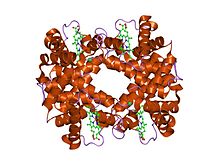Loading AI tools
Superfamily of oxygen-transporting globular proteins From Wikipedia, the free encyclopedia
The globins are a superfamily of heme-containing globular proteins, involved in binding and/or transporting oxygen. These proteins all incorporate the globin fold, a series of eight alpha helical segments. Two prominent members include myoglobin and hemoglobin. Both of these proteins reversibly bind oxygen via a heme prosthetic group. They are widely distributed in many organisms.[2]
| Globin family (family M) | |||||||||
|---|---|---|---|---|---|---|---|---|---|
 the Structure of deoxyhemoglobin Rothschild 37 beta Trp----Arg: a mutation that creates an intersubunit chloride-binding site.[1] | |||||||||
| Identifiers | |||||||||
| Symbol | Globin | ||||||||
| Pfam | PF00042 | ||||||||
| Pfam clan | CL0090 | ||||||||
| ECOD | 106.1.1 | ||||||||
| InterPro | IPR000971 | ||||||||
| PROSITE | PS01033 | ||||||||
| SCOP2 | 1hba / SCOPe / SUPFAM | ||||||||
| CDD | cd01040 | ||||||||
| |||||||||
| Bacterial-like Globin (family T) | |||||||||
|---|---|---|---|---|---|---|---|---|---|
 crystal structure of "truncated" hemoglobin n (hbn) from mycobacterium tuberculosis, soaked with xe atoms | |||||||||
| Identifiers | |||||||||
| Symbol | Bac_globin | ||||||||
| Pfam | PF01152 | ||||||||
| Pfam clan | CL0090 | ||||||||
| InterPro | IPR001486 | ||||||||
| PROSITE | PDOC00933 | ||||||||
| SCOP2 | 1dlw / SCOPe / SUPFAM | ||||||||
| CDD | cd14756 | ||||||||
| |||||||||
Globin superfamily members share a common three-dimensional fold.[3] This 'globin fold' typically consists of eight alpha helices, although some proteins have additional helix extensions at their termini.[4] Since the globin fold contains only helices, it is classified as an all-alpha protein fold.
The globin fold is found in its namesake globin families as well as in phycocyanins. The globin fold was thus the first protein fold discovered (myoglobin was the first protein whose structure was solved).
The eight helices of the globin fold core share significant nonlocal structure, unlike other structural motifs in which amino acids close to each other in primary sequence are also close in space. The helices pack together at an average angle of about 50 degrees, significantly steeper than other helical packings such as the helix bundle. The exact angle of helix packing depends on the sequence of the protein, because packing is mediated by the sterics and hydrophobic interactions of the amino acid side chains near the helix interfaces.
Globins evolved from a common ancestor and can be divided into three lineages:[5][6]
The M/F family of globins is absent in archaea. Eukaryotes lack GCS, Pgb, and T3 subfamily globins.[7]
Eight globins are known to occur in vertebrates: androglobin (Adgb), cytoglobin (Cygb), globin E (GbE, from bird eye), globin X (GbX, not found in mammals or birds), globin Y (GbY, from some mammals), hemoglobin (Hb), myoglobin (Mb) and neuroglobin (Ngb).[7] All these types evolved from a single globin gene of F/M family[7] found in basal animals.[9] The single gene has also invented an oxygen-carrying "hemoglobin" multiple times in other groups of animals.[10] Several functionally different haemoglobins can coexist in the same species.
Although the fold of the globin superfamily is highly evolutionarily conserved, the sequences that form the fold can have as low as 16% sequence identity. While the sequence specificity of the fold is not stringent, the hydrophobic core of the protein must be maintained and hydrophobic patches on the generally hydrophilic solvent-exposed surface must be avoided in order for the structure to remain stable and soluble. The most famous mutation in the globin fold is a change from glutamate to valine in one chain of the hemoglobin molecule. This mutation creates a "hydrophobic patch" on the protein surface that promotes intermolecular aggregation, the molecular event that gives rise to sickle-cell disease.[citation needed]
Human genes encoding globin proteins include:
The globins include:
The globin fold (cd01067) also includes some non-haem proteins. Some of them are the phycobiliproteins, the N-terminal domain of two-component regulatory system histidine kinase, RsbR, and RsbN.
Seamless Wikipedia browsing. On steroids.
Every time you click a link to Wikipedia, Wiktionary or Wikiquote in your browser's search results, it will show the modern Wikiwand interface.
Wikiwand extension is a five stars, simple, with minimum permission required to keep your browsing private, safe and transparent.